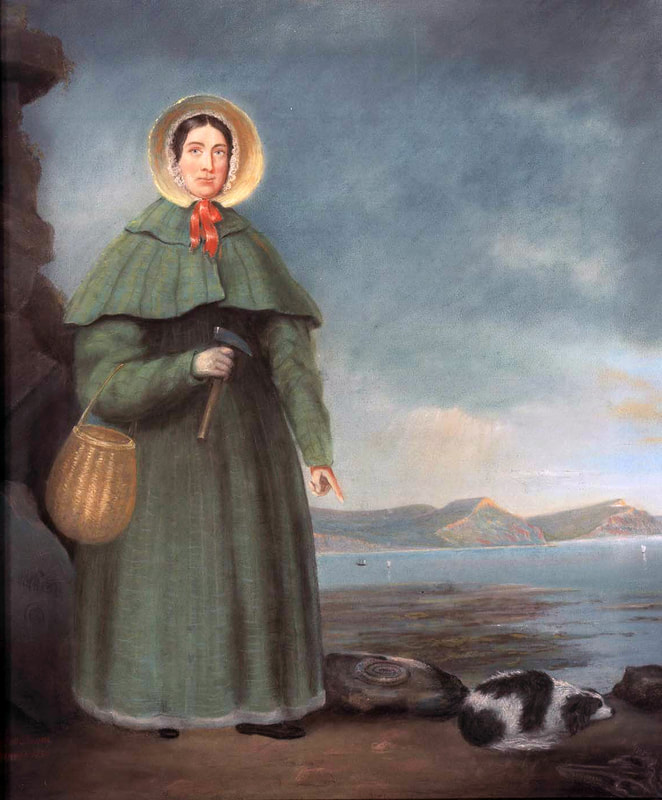|
The area up and down the coast around Lyme Regis—the Jurassic Coast—is a one-of-a-kind geological marvel: The kind that doesn’t exist anywhere else on the planet. The kind that draws famous experts and everyday tourists from all over the world, including—now—me and Bob. The area also played a major role in the advancement of Darwin’s theory of evolution. What more could you want, history- and geology-wise, from a town? Why Lyme Regis is a geological marvel: Maybe you remember learning about the Mesozoic Era and how it’s made up of three highly popular* time periods: the Triassic, Jurassic, and Cretaceous. In case you don't, this was the era of giant reptiles and crazy looking dinosaurs, some of which caused quite a ruckus and rending of cloth and high consternation among and between Darwinians, scientists, and especially, the church. It got ugly. *Highly Popular mostly and especially for rock geeks, which I have always been, and dinosaur buffs, which I am not. The Mesozoic Era ended 66 million years ago and covers 185 million years of earth history, which is one mighty long timeline to hang on your wall. Lyme Regis is the only place in the world where you can stroll along the coast and cliffs and witness an almost complete timeline of rocks, fossils, and landforms from the Mesozoic Era: 185 million years of geological history, all in one place, spread out like a book going back in time. Or forward if you're walking the other direction. Here’s all I know about the profound geological changes that occurred during the Mesozoic Era. (And here’s all I know about Plate Tectonics and Mohorovicic Discontinuity, more cool geological things.)
How Lyme Regis played a huge role in laying the foundations for the theory of evolution: In 1811, a 12-year-old girl named Mary, along with her brother Joseph, discovered a 17ft skeleton along the coast at Lyme. The creature, now known to be an ichthyosaur, was a swimming, dolphin-like reptile with large eyes. Strangely, it had more in common with modern lizards than it did with fish. Twelve years later, Mary found the first complete skeleton of a plesiosaur, a marine reptile so bizarre that scientists declared it a fake. Then Mary unearthed the UK's first known remains of a pterosaur, believed to be the largest-ever flying animal. And this is when the proverbial sh!t hit the fan. 1811 was a time before people knew about dinosaurs. A time when the word evolution was only being whispered among a small group of forward thinkers. A time when the prevailing belief was that the earth had been made in six divinely ordained 24-hour time slots. During these time slots God created the sun, moon, stars, oceans, creatures of the air, land, and sea, and then, on the sixth day, his greatest masterpiece of all: man. The church was adamant and united and confident that all life species—every last one of them—were created during those six days, which they determined had occurred six thousand years earlier. They were also adamant that a loving God would never allow extinction among his glorious creations. Would She? So as fossils were excavated they generated not only amazement and wonder at the terrifying monsters buried in the earth, but also fear and anxiety: The church was aghast by what appeared to be a direct challenge to the accepted creation wisdom. It was a terrible affront. How could evidence that the earth was billions of years old be squared with the Biblical orthodoxy that the earth was only a few thousand years old? Evidence was growing that showed the earth to be much, much older, and that creatures came and went and morphed with and into other creatures. Mary’s finds in particular sparked decades of debate: Just how old is life on this planet? How/why could creatures eventually disappear and/or seem to blend into other creatures? And how then, did humans fit into this new picture? Mary’s ichthyosaur, Greek for ‘fish’ and ‘lizard,’ as well as her other finds, all of which bore witness to a strange, rich prehistory heretofore never imagined, was yet more evidence that would eventually prove conventional knowledge wrong. All this from a 12-year-old in Lyme Regis.
She sells seashells by the seashoreMary Anning was the inspiration for this tongue-twister. It was originally a song, written by Terry Sullivan and put to music by Harry Gifford in 1908, inspired by Mary Anning's life because she did in fact sell seashells by the seashore. Who knew? She sells seashells by the seashore.
0 Comments
Your comment will be posted after it is approved.
Leave a Reply. |
